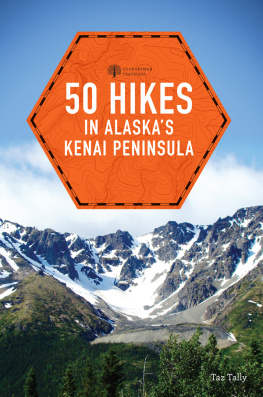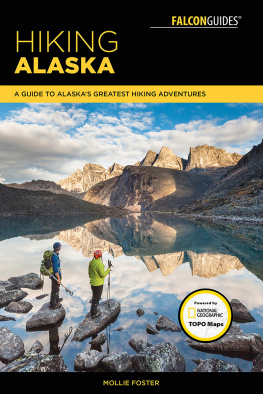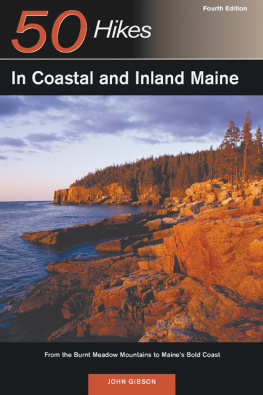

Id rather wake up in the middle of nowhere than in any city on earth.
Steve McQueen
For Zip, whose joy and companionship made hiking all these trails a much more enjoyable adventure!






CONTENTS
I have been blessed with the help of numerous people in the creation of both editions of this book, and I would like to acknowledge some of them here. First, to my constant companion for 18+ years and my always-eager hiking partner, Zip the wonder dog, I offer a very special thank-you for all the years, trails, and adventures we shared and for all the joy you brought to my life. To my human partner, Christina Whiting, I offer many thanks for the hiking companionship, support, and all the great editing as well. And I offer many big smiles and thank-yous to my hiking partners Katie Koester, Dottie Harness, Karin Marks, Hope, Ellie and Nancy Lasater, and Jim and Karen Hurd for making my hiking and the creation of this book far more enjoyable! I acknowledge and thank cartographer extraordinaire Tibor G. Tth for the wonderful 3-D topographic location map he contributed to this book. Viewing his map allows you to truly visualize the topography of the Kenai Peninsula without actually being here. And speaking of maps, I offer appreciation to Mike Gracz for sharing his easy-to-read and very helpful guide maps of Eveline State Recreation Area. Thanks to Marie McCarty, executive director of the Kachemak Heritage Land Trust, for her input on the Calvin and Coyle Trail, and to Carmen Field, aquatic education specialist and naturalist for the Alaska Department of Fish and Game, for sharing her birding insights and expertise. Also, thank you to Jason Oakley with Kachemak Bay State Park for his assistance on updating the information on the State Park trails. And big appreciation to Matt Conner, visitor services manager for Kenai National Wildlife Refuge; Scott Slavik, visitor service specialist and trails program coordinator for Kenai National Wildlife Refuge; Kristi Bulock, fire manager officer for Kenai National Wildlife Refuge; and Candace Ward, information and education program supervisor for the Kenai National Wildlife Refuge, for all the good conversations, information, and support, and for the great hike to Marsh Lake during the creation of this second edition. I am very appreciative of Alison Rein, recreation planner for the Chugach National Forests Glacier Ranger District, for providing maps and information on the Spencer Glacier hikes and area, and for her excellent editing suggestions as well. For John Eavis, recreation staff manager for Chugach National Forests Seward Ranger District, I offer a shout-out for his help with the updated, and much improved, Gull Rock and Hope Point trails. I also want to include one special acknowledgment for Dave Brand for all the help he has provided me, and others, on this and so many projects, and particularly for his leadership and hard work on his vision for Kac hemak Bay Water Trail, which can be used to access many of the acrossKachemak Bay hikes covered in Part V of this book. And finally, thank you to my agent, Matt Wagner of Fresh Books, for helping me get started on the original 50 Hikes project!
S ince the publication of the first edition of this guide in 2008, several new hiking trails on the Kenai Peninsula have been developed, and I have included some of them in this second edition. Added hikes include the Spencer Glacier trails in the Northern Kenai, the Vista and Marsh Lake trails in the Central Kenai, and the Eveline State Recreation Area trail system in the Southeast Kenai. Other trails, such as the Calvin and Coyle trail in Homer, have undergone significant improvements, and I am delighted to be able to provide updates for them. Because I am adding four new hikes, in order to maintain the books 50 Hikes title, I have combined six related trails that I introduced in the first edition into three trails. These are the Caines Head and Caines Head Alpine trails; the Homestead and Crossman Ridge Extension trails; and the Diamond Gulch and Diamond Gulch to Bishops Beach trails. I have only removed one trail, the Homer Spit beachwalk.

ONE OF THE MANY UNNAMED PEAKS IN THE KENAI MOUNTAINS
L ike all The Great Land that is Alaska, the Kenai Peninsula is like no other place on earth. Kenai is often referred to as a mini Alaska because it contains stunning examples of much of what makes Alaska such a compelling landscape to both visit and to call home. This includes soaring, rugged mountains; crystalline hundred-mile views; wild, colorful rivers; grinding, glorious glaciers; large, land-based wildlife; even more massive marine wildlife; unbelievable fish; grand lakes; huge tides; forests galore; exquisite alpine tundra; and nearly 24 hours of daily sunlight in the summer months to take it all in. This book covers 50 of the most spectacular hikes on the Kenai Peninsula and provides a guide to visiting these grand Alaskan natural wonders.
This is the first book to comprehensively cover the hikes of the Kenai Peninsula, and so it was written with great love and careful stewardship over several years. The hikes come in all lengths and levels of difficulty, from easy beach strolls near populated areas to hardy multiday treks through remote wilderness, but every hike is meant to provide something marvelous that is uniquely Alaskan. You are invited to lace up your boots and read along with the author, a PhD geologist and landscape photographer who has chosen every trail, then walked and photographed each one several times in order to give you the most thorough, personally guided, professional tour possible.
Welcome to the Kenai (pronounced Keen-eye) and enjoy! This introduction briefly covers:
Geography of the Kenai Peninsula
Geology of the Kenai Peninsula
Hiking Tips: Gear
Hiking Techniques and Tips
Hiking Choices and Ratings
Information Resources
GEOGRAPHY OF THE KENAI PENINSULA
Located in south-central Alaska, the Kenai (from the Russian word Kenayskaya ) extends south from Anchorage and the slicing Turnagain Arm of Cook Inlet for 150 miles. Its maximum width is 80 miles near midpeninsula.
The Kenai is so large (at 16,013 square miles or 41,473 square kilometers) that it is 50 percent bigger than the entire state of Maryland. It is also larger than New Hampshire, Massachusetts, New Jersey, Hawaii, Connecticut, Delaware, and Rhode Island. Its so big, in fact, that you could combine those last four states and still have enough square miles left to include Delaware again. The Harding Icefield (Hike #16) alone is larger than the whole state of Rhode Island!
Next page














